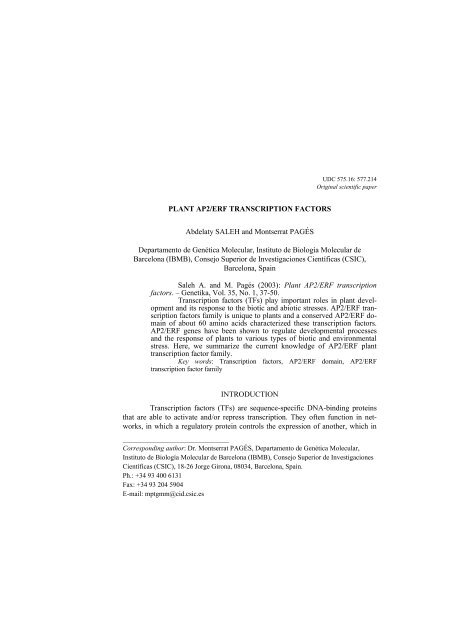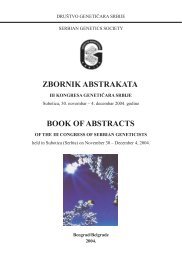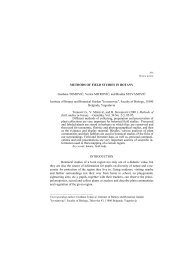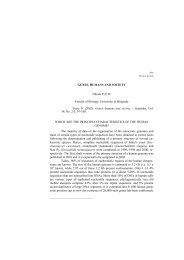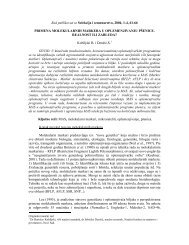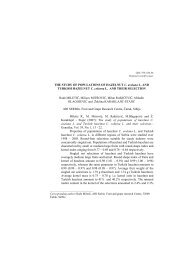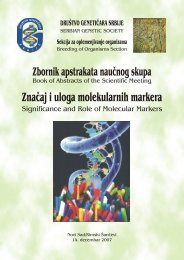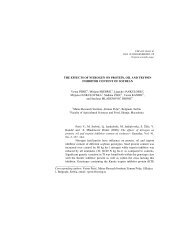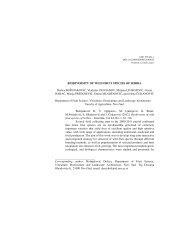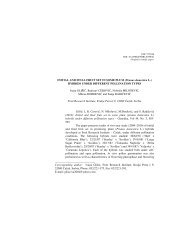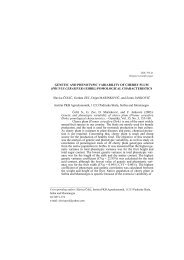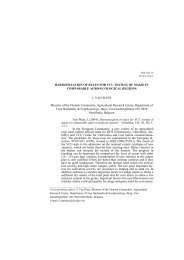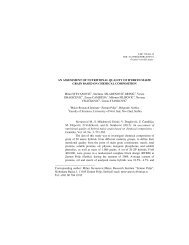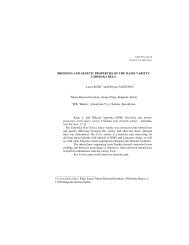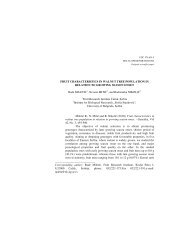Plant AP2/ERF transcription factors
Plant AP2/ERF transcription factors
Plant AP2/ERF transcription factors
You also want an ePaper? Increase the reach of your titles
YUMPU automatically turns print PDFs into web optimized ePapers that Google loves.
PLANT <strong>AP2</strong>/<strong>ERF</strong> TRANSCRIPTION FACTORS<br />
Abdelaty SALEH and Montserrat PAGÉS<br />
UDC 575.16: 577.214<br />
Original scientific paper<br />
Departamento de Genética Molecular, Instituto de Biología Molecular de<br />
Barcelona (IBMB), Consejo Superior de Investigaciones Científicas (CSIC),<br />
Barcelona, Spain<br />
Saleh A. and M. Pagés (2003): <strong>Plant</strong> <strong>AP2</strong>/<strong>ERF</strong> <strong>transcription</strong><br />
<strong>factors</strong>. – Genetika, Vol. 35, No. 1, 37-50.<br />
Transcription <strong>factors</strong> (TFs) play important roles in plant development<br />
and its response to the biotic and abiotic stresses. <strong>AP2</strong>/<strong>ERF</strong> <strong>transcription</strong><br />
<strong>factors</strong> family is unique to plants and a conserved <strong>AP2</strong>/<strong>ERF</strong> domain<br />
of about 60 amino acids characterized these <strong>transcription</strong> <strong>factors</strong>.<br />
<strong>AP2</strong>/<strong>ERF</strong> genes have been shown to regulate developmental processes<br />
and the response of plants to various types of biotic and environmental<br />
stress. Here, we summarize the current knowledge of <strong>AP2</strong>/<strong>ERF</strong> plant<br />
<strong>transcription</strong> factor family.<br />
Key words: Transcription <strong>factors</strong>, <strong>AP2</strong>/<strong>ERF</strong> domain, <strong>AP2</strong>/<strong>ERF</strong><br />
<strong>transcription</strong> factor family<br />
INTRODUCTION<br />
Transcription <strong>factors</strong> (TFs) are sequence-specific DNA-binding proteins<br />
that are able to activate and/or repress <strong>transcription</strong>. They often function in networks,<br />
in which a regulatory protein controls the expression of another, which in<br />
_______________________________<br />
Corresponding author: Dr. Montserrat PAGÉS, Departamento de Genética Molecular,<br />
Instituto de Biología Molecular de Barcelona (IBMB), Consejo Superior de Investigaciones<br />
Científicas (CSIC), 18-26 Jorge Girona, 08034, Barcelona, Spain.<br />
Ph.: +34 93 400 6131<br />
Fax: +34 93 204 5904<br />
E-mail: mptgmm@cid.csic.es
38 GENETIKA, Vol. 35, No. 1, 37-50, 2003.<br />
turn may modulate the expression of other regulators genes or control genes encoding<br />
structural proteins or enzymes. Transcription <strong>factors</strong> are responsible for the<br />
selectivity in gene regulation and are often expressed in tissue-specific, development-stage-specific<br />
or via stimulus-dependent pathways (LIU et al., 1999; ZHANG<br />
2003; DAVULURI et al., 2003).<br />
A typical plant <strong>transcription</strong> factor contains, with few exceptions, a DNAbinding<br />
domain, an oligomerization site, a <strong>transcription</strong>-regulation domain, and a<br />
nuclear localization signal, although some lack either a <strong>transcription</strong> regulation<br />
domain or specific DNA-binding domain (GOFF et al., 1992; HILL et al., 1996;<br />
DOEBLEY and LUKENS 1998). The DNA-binding domain is responsible for the union<br />
of the TFs to specific cis-regulatory DNA sequences in the promoters of genes<br />
that they regulate. Most <strong>transcription</strong> <strong>factors</strong> exhibit only one type of DNA-binding<br />
and oligomerization domain, occasionally in multiple copies, but some contain two<br />
distinct types of DNA-binding domain. Several plant <strong>transcription</strong> <strong>factors</strong> posses<br />
both specific and non-specific DNA-binding domains, with the later occasionally<br />
necessary for the transactivation of target genes (HERR et al., 1988; HERR and<br />
CLEARY, 199; MARTIN and PAZ-ARES, 1997; KAGAYA et al., 1999).<br />
Many plant <strong>transcription</strong> <strong>factors</strong> form hetero-and/or homo-oligomers affecting<br />
the DNA-binding specificity. Regulation domains and hence, <strong>transcription</strong><br />
<strong>factors</strong> functions as either repressors or activators, depending on whether they inhibit<br />
or stimulate the <strong>transcription</strong> of target genes (DIETRICH et al., 1997; YA-<br />
NAGISAWA and SHEEN 1998). The plant <strong>transcription</strong> <strong>factors</strong> contain nuclear localization<br />
signal (NLS) characterized by a core peptide enriched in Arginine and<br />
Lysine. Some plant <strong>transcription</strong> <strong>factors</strong> may lack an NLS and they are thought to<br />
be imported in the nucleus by dimerizing with proteins that posse these signals<br />
(GOLDFARB and LEWANDOWSKA, 1994; LYCK et al., 1997). Engineering of plant<br />
<strong>transcription</strong> factor genes provides a valuable means for genetic manipulation of<br />
plants. In this review, we summarize our knowledge about the <strong>AP2</strong>/<strong>ERF</strong> <strong>transcription</strong><br />
<strong>factors</strong> family, classification of <strong>AP2</strong>/<strong>ERF</strong> genes and their function during plant<br />
life cycle.<br />
<strong>AP2</strong>/<strong>ERF</strong> TRANSCRIPTION FACTORS<br />
Classification of <strong>AP2</strong>/<strong>ERF</strong> <strong>transcription</strong> <strong>factors</strong> - Based in the number<br />
of copies of <strong>AP2</strong>/<strong>ERF</strong> domain and their sequence similarity, The <strong>AP2</strong>/<strong>ERF</strong><br />
proteins have been subdivided into five subfamilies (SAKUMA et al., 2002): <strong>AP2</strong><br />
subfamily, DREB subfamily, <strong>ERF</strong> subfamily, RAV subfamily and others. Members<br />
of the <strong>AP2</strong> subfamily contain two <strong>AP2</strong>/<strong>ERF</strong> domains connected by a conserved<br />
linker of 25 amino acid such as <strong>AP2</strong>, ANT, Glossy15, AtBBM and BnBBM.<br />
Members of the DREB, <strong>ERF</strong> and other subgroups contain a single <strong>AP2</strong>/<strong>ERF</strong><br />
domain, such as ZmDBFs, Nt<strong>ERF</strong>s, AtDREBs, AtCBFs, LePtis, AtEBP and<br />
At<strong>ERF</strong>s (KIZIS and PAGES, 2002; RIECHMANN et al., 2000; SAKUMA et al., 2002).<br />
However, the RAV subfamily (RAV: for Related to ABI3/VP1) includes genes that<br />
conserved two different DNA-binding domains, <strong>AP2</strong>/<strong>ERF</strong> and B3. B3 DNA-
A.SALEH et al.: PLANT <strong>AP2</strong>/<strong>ERF</strong> TRANSCRIPTION FACTORS 39<br />
binding domain is conserved in VP1/ABI3) as shown in Fig. 1 (GIRAUDAT et al.,<br />
1992; KAGAYA et al., 1999).<br />
<strong>AP2</strong><br />
DREB/<strong>ERF</strong><br />
RAV<br />
L<br />
<strong>AP2</strong>/<strong>ERF</strong> <strong>AP2</strong>/<strong>ERF</strong><br />
<strong>AP2</strong>/<strong>ERF</strong><br />
<strong>AP2</strong>/<strong>ERF</strong><br />
Fig. 1. Schematic illustrations of domain organization of <strong>AP2</strong>, DREB, <strong>ERF</strong> and RAV<br />
proteins<br />
<strong>AP2</strong>/<strong>ERF</strong> Domain structure - A conserved <strong>AP2</strong>/<strong>ERF</strong> domain of about<br />
60-70 amino acids characterized the <strong>AP2</strong>/<strong>ERF</strong> <strong>transcription</strong> <strong>factors</strong> with no<br />
apparent similarity outside this domain (RIECHMANN and MEYEROWITZ, 1998).<br />
The <strong>AP2</strong>/<strong>ERF</strong> domain was originally identified in APETALA2 of Arabidopsis<br />
(JOFUKU et al., 1994) and EREBP1 of tobacco (OHME-TAKAGI and SHINSHI, 1995).<br />
The <strong>AP2</strong>/<strong>ERF</strong> domain is a new type of DNA-binding module that includes two<br />
regions: The YRG region (YRG element) of about 20-amino acid-long N-terminal<br />
stretch rich in basic and hydrophilic residues. It was proposed to have a role in the<br />
DNA binding by making a direct contact with the DNA because of it basic<br />
character (OKAMURO et al, 1997).<br />
The RAYD region of about 40-amino acids (RAYD element) in the Cterminal<br />
sequence of the domain contains of 18 amino acids capable of forming an<br />
amphipathic α-helix and is thought to have an important role for the structure and<br />
function of the domain (JOFUKU et al., 1994; OKAMURO et al, 1997). The RAYD<br />
element was proposed to mediate protein-protein interactions through α-helix or to<br />
have an alternative role in DNA binding through interactions of hydrophobic face<br />
of the α-helix with the major groove of DNA. DRE-binding proteins contain specific<br />
residues within their <strong>AP2</strong>/<strong>ERF</strong> domain that may determine their ability to<br />
bind the DRE/C-repeat element (JOFUKU et al., 1994; OKAMURO et al, 1997; KIZIS<br />
et al., 2000; SAKOMA et al., 2002).<br />
The solution structure of the <strong>AP2</strong>/<strong>ERF</strong> domain of At<strong>ERF</strong>1 bound to the<br />
GCC box (5'-AGCCGCC-3') indicated that the protein uses an anti-parallel threestranded<br />
ß-sheet to make major groove contacts. The ß-sheet packs against an αhelix<br />
that runs approximately parallel to the sheet. This structure is stabilized by an<br />
extensive number of hydrophobic contacts. The majority of DNA contacts are<br />
made by Arginine and Tryptophan residues located in the ß-sheet of the protein<br />
(ALLEN et al., 1998).<br />
B3
40 GENETIKA, Vol. 35, No. 1, 37-50, 2003.<br />
The existence of repeated DNA-binding domains not unique to <strong>AP2</strong>/<strong>ERF</strong><br />
<strong>transcription</strong> <strong>factors</strong>. The WRKY family of <strong>transcription</strong> <strong>factors</strong> consists of proteins<br />
that contain either a single or a repeated DNA-binding domain (RUSHTON et<br />
al., 1995). A repeated DNA-binding motif is also found in the MYB family of<br />
<strong>transcription</strong> <strong>factors</strong>, the MYB DNA-binding domain consists normally of three<br />
repeats (R1, R2 and R3) in animal MYB proteins and two repeats (R2 and R3) in<br />
plant MYB proteins (MARTIN and PAZ-ARES, 1997).<br />
In other eukaryotes, only a few families of <strong>transcription</strong> <strong>factors</strong> with distinct<br />
DNA-binding domains include POU-domain proteins (HERR et al., 1988) and<br />
Pax proteins (CZERNY et al., 1993), both of which have been studied extensively<br />
with respect to how the multiple DNA binding structures contribute to the specificity<br />
and affinity of DNA-binding (VERRIJZER et al., 1992; JUN and DESPLAN<br />
1996). The POU-domain consists of two subdomains, a POU-specific domain<br />
(POUS) and a POU-type homeo-domain (POUHD), that cooperate functionally as<br />
one binding unit (HERR and CLEARY, 1995). The paired-domain (PD) of Pax proteins<br />
also consists of two subdomains, PAI and RED, both of which contain a helix-turn-helix<br />
(HTH) DNA-binding motif. Many Pax proteins contain a homeodomain<br />
(HD) in addition to PD. Thus, these proteins contain three HTHs and have<br />
been shown to recognize different types of target sites using multiple combinations<br />
of their HTHs (JUN and DESPLAN, 1996).<br />
<strong>AP2</strong> subfamily<br />
R1 (Repeat1)<br />
------YRG----------- -----------RAYD-----------------------<br />
consensus .S.YRGVT..R.TGR.E.H.WD...........G.QVYLGG.D....AARAYD.AA.K..G.....NF....Y....<br />
At<strong>AP2</strong> 1 SSQYRGVTFYRRTGRWESHIWD----------CGKQVYLGGFDTAHAAARAYDRAAIKFRGVEADINFNIDDYDDDL 67<br />
Glossy15 1 SSQYRGVTFYRRTGRWESHIWD----------CGKQVYLGGFDTAQAAARAYDQAAIKFRGLNADINFTLDDYKDEM 67<br />
ZmINSPIK1 1 SSQYRGVTFYRRTGRWESHIWD----------CGKQVYLGGFDTAHAAARAYDRAAIKFRGLDADINFSLSDYEDDL 67<br />
ANT 1 TSQYRGVTRHRWTGRYEAHLWDNSFKKEGHSRKGRQVYLGGYDMEEKAARAYDLAALKYWGPSTHTNFSAENYQKEI 77<br />
BnBBM2 1 TSIYRGVTRHRWTGRYEAHLWDNSCKREGQTRKGRQVYLGGYDKEEKAARAYDLAALKYWGTTTTTNFPMSEYEKEI 77<br />
AtBBM 1 TSIYRGVTRHRWTGRYEAHLWDNSCKREGQTRKGRQVYLGGYDKEEKAARAYDLAALKYWGPTTTTNFPLSEYEKEV 77<br />
Linker<br />
Consensus ..M......E.V..LRR...GF.RG<br />
At<strong>AP2</strong> 1 EEMKHMTRQEYVASLRRKSSGFSRG 25<br />
Glossy15 1 EEMKHMTRQEYVASLRRKSSGFSRG 25<br />
ZmINSPIK1 1 EDMKNMTRQEYVAHLRRKSSGFSRG 25<br />
ANT 1 KQMTNLTKEEFVHVLRRQSTGFPRG 25<br />
BnBBM2 1 KQMRNWTKEEFVHILRRQSTGFARG 25<br />
AtBBM 1 KKMKDLSKEEFVLVLRRQGAGFVRG 25<br />
R2 (Repeat2)<br />
---------YRG--------------- ------------------RAYD------------------<br />
Consensus .S..RGVT..H..G.W.AR.G...G.K..YLG......EAA.AYD.AA....G..AVTNF....Y....<br />
At<strong>AP2</strong> 1 SSKYRGVT-LHKCGRWEARMGQFLGKKYVYLGLFDTEVEAARAYDKAAIKCNGKDAVTNFDPSIYDEEL 68<br />
Glossy15 1 SSRFRGVT-QHKCGKWEARIGQLMGKKYVYLGLYDTETEAAQAYDKAAIKCYGKEAVTNFDAQSYDKEL 68<br />
ZmINSPIK1 1 SSKYRGVT-LHKCGRWEARMGQLLGKKYIYLGLFDSEVEAARAYDRAALRFNGREAVTNFEPSSYNAGD 68<br />
ANT 1 ASIYRGVTRHHQHGRWQARIGRVAGNKDLYLGTFGTQEEAAEAYDVAAIKFRGTNAVTNFDITRYDVDR 69<br />
BnBBM2 1 ASIYRGVTRHHQHGRWQARIGRVAGNKDLYLGTFGTQEEAAEAYDIAAIKFRGLTAVTNFDMNRYNVKA 69<br />
AtBBM 1 ASIYRGVTRHHQHGRWQARIGRVAGNKDLYLGTFGTQEEAAEAYDIAAIKFRGLSAVTNFDMNRYNVKA 69<br />
Fig 2. cont. on next page ….
A.SALEH et al.: PLANT <strong>AP2</strong>/<strong>ERF</strong> TRANSCRIPTION FACTORS 41<br />
… Fig 2. cont. from previous page<br />
(B) DREB subfamily<br />
------------YRG-------- -----------------RAYD---------------<br />
consensus ...RG.R.R...G.WV.E.R.P.....R.WLG.F.TA..AA.A.D.A...............<br />
ZmDBF1 1 KLYRGVRQR-HWGKWVAEIRLP-RNRTRLWLGTFDTAEQAALAYDQAAYRLRGDAARLNFPD 60<br />
ZmDBF2 1 PTFRGVRMR-AWGKWVSEIREP-RKKSRIWLGTFPTAEMAARAHDVAALAIKGRAAHLNFPD 60<br />
AtDREB1A 1 PIYRGVRRR-NSGKWVCEVREP-NKKTRIWLGTFQTAEMAARAHDVAALALRGRSACLNFAD 60<br />
AtDREB1B 1 PIYRGVRQR-NSGKWVSEVREP-NKKTRIWLGTFQTAEMAARAHDVAALALRGRSACLNFAD 60<br />
AtDREB1C 1 PIYRGVRQR-NSGKWVCELREP-NKKTRIWLGTFQTAEMAARAHDVAAIALRGRSACLNFAD 60<br />
AtDREB2A 1 CSFRGVRQR-IWGKWVAEIREP-NRGSRLWLGTFPTAQEAASAYDEAAKAMYGPLARLNFPR 60<br />
AtDREB2B 1 CSFRGVRQR-IWGKWVAEIREP-KIGTRLWLGTFPTAEKAASAYDEAATAMYGSLARLNFPQ 60<br />
OsDREB1A 1 PVFRGVRRRGNAGRWVCEVRVPGRRGCRLWLGTFDTAEGAARAHDAAMLAINAGGGGGGGAC 62<br />
OsDREB2A 1 CAYRGVRQR-TWGKWVAEIREP-NRGRRLWLGSFPTALEAAHAYDEAARAMYGPTARVNFAD 60<br />
TaDREB1 1 CAYRGVRQR-TWGKWVAEIREP-NRGNRLWLGSFPTAVEAARAYDDAARAMYGAKARVNFSE 60<br />
AtCBF1 1 PIYRGVRQR-NSGKWVSEVREP-NKKTRIWLGTFQTAEMAARAHDVAALALRGRSACLNFAD 60<br />
AtCBF2 1 PIYRGVRQR-NSGKWVCELREP-NKKTRIWLGTFQTAEMAARAHDVAAIALRGRSACLNFAD 60<br />
AtCBF3 1 PIYRGVRRR-NSGKWVCEVREP-NKKTRIWLGTFQTAEMAARAHDVAALALRGRSACLNFAD 60<br />
BnCBF5 1 PIYRGVRQR-HSGKWVCEVREP-NKKSRIWLGTFLTAEIAARAHDVAAIALRGKSACLNFAD 60<br />
BnCBF7 1 PVYRGXRLR-NSGKWVCEVREP-NKKSRIWLGTFLTAEIAARAHDVAAIALRGKSACLNFAD 60<br />
BnCBF16 1 PVYRGVRLR-NSGKWVCEVREP-NKKSRIWLGTFLTAEIAARAHDVAAIALRGKSACLNFAD 60<br />
BnCBF17 1 PIYRGVRLR-KSGKWVCEVREP-NKKSRIWLGTFKTAEIAARAHDVAALALRGRGACLNFAD 60<br />
Fig. 2: Sequence Comparison of the <strong>AP2</strong>/<strong>ERF</strong> Domain of subfamilies of <strong>AP2</strong>/<strong>ERF</strong> family.<br />
The amino acid sequences of the <strong>AP2</strong>/<strong>ERF</strong> domain repeat (Repeat 1), the second <strong>AP2</strong>/<strong>ERF</strong><br />
domain repeat (Repeat 2) of <strong>AP2</strong> subfamily, and the linker region lying between the two<br />
repeats (Linker) (A), and <strong>AP2</strong>/<strong>ERF</strong> domain of DREB (B), were aligned The shaded boxes<br />
presented the amino acid identity (dark grey; the identical amino acids, medium grey: the<br />
similar amino acids, light grey: the rest of the amino acids). Protein names are indicated at<br />
the left. Accession numbers correspond to NCBI database of analysed proteins are the<br />
following; AtAPETALA2 (P47927), Inspik1 (T01574), Glossy15 (T03981),<br />
AINTEGUMENTA (AAA91040), BnBBM2 (AF317905), AtBBM (AF317907),<br />
ZmDBF1 (AAM80486), ZmDBF2 (AAM80485), AtDREB1A (BAA33791), AtDREB1B<br />
(BAA33792), AtDREB1C (BAA33793), AtDREB2A (BAA33794) AtDREB2b<br />
(BAA33795), OsDREB1A (AAN02486) OsDREB2A (AAN02487),<br />
TaDREB1(AAL01124), AtCBF1(AAC49662), AtCBF2 (AAD15976), AtCBF3<br />
(AAD15977), BnCBF5 (AAM18958), BnCBF7 (AAM18959), BnCBF16 (AAM18960),<br />
BnCBF17 (AAM18961).<br />
Linker importance of <strong>AP2</strong>/<strong>ERF</strong> protein-DNA interaction - The<br />
<strong>AP2</strong>/<strong>ERF</strong> DNA binding domain exists as a single repeat in the DREB, <strong>ERF</strong>, RAV<br />
and other subfamilies, while as a double repeat in the <strong>AP2</strong> subfamily with the later<br />
containing a linker sequence of twenty-five amino acids in between the two repeats<br />
as shown in Fig. 2. This linker sequence has a high level of amino acid<br />
conservation in all members of the subfamily and a critical role for the function of<br />
<strong>AP2</strong>/<strong>ERF</strong> domain, since mutation inside the linker abolishes the ability of the<br />
proteins for DNA-binding (KLUCHER et al., 1996). A 10–amino acid insertion in<br />
the first <strong>AP2</strong>/<strong>ERF</strong> DNA-binding domain (Repeat1) exist in several <strong>AP2</strong>/<strong>ERF</strong><br />
proteins such as AtBBM, BnBBM and ANT proteins distinguishes of these<br />
proteins from other <strong>AP2</strong>/<strong>ERF</strong> proteins such as <strong>AP2</strong> and Gl15. THE function of<br />
these 10-amino acids is not yet known (BOUTILIER et al., 2002).<br />
The conserved nature of the linker in <strong>AP2</strong>/<strong>ERF</strong> proteins and the identification<br />
of several linker residues in ANT that are indispensable for DNA binding<br />
suggests that this region directly contacts DNA or functions in positioning the two<br />
<strong>AP2</strong>/<strong>ERF</strong> repeats on DNA (KRIZEK, 2003). Also, in zinc finger proteins and Myb<br />
proteins, the DNA-binding domains (zinc fingers or helix–turn–helix related mo-
42 GENETIKA, Vol. 35, No. 1, 37-50, 2003.<br />
tifs) are connected by well conserved linkers (5 or 13 amino acids) that allow the<br />
independent structural units to contact with the DNA. The importance of these<br />
linkers thus appears to derive primarily from a role in positioning of the DNAbinding<br />
domains (WOLFE et al., 2000).<br />
Table 1. Cis –acting elements essential for <strong>AP2</strong>/<strong>ERF</strong> proteins<br />
Cis-element <strong>Plant</strong> specie Protein Ref.<br />
Drought Responsive element Arabidopsis thaliana DREBs Liu et al., 1998<br />
(DRE/CRT)<br />
CBFs Stockinger et al., 1997<br />
Gilmour et al., 1998<br />
5'TACCGACAT3'<br />
Haake et al., 2002<br />
Low Temperature Responsive<br />
Element (LTRE)<br />
5' (G/a)(C/t)CGAC3'<br />
Ethylene Responsive Element<br />
(ERE or GCC box)<br />
5'TAAGAGCCGCC3'<br />
or<br />
5'AGCCGCC3'<br />
JA- and elicitor-responsive<br />
element (JERE)<br />
5'-AGACCGCC-3'<br />
Bipartite sequence<br />
5'CAACA-(N)n -CACCTG3'<br />
ANT consensus site<br />
5'gCAC(A/G)N(A/T)TcCC(a/g)<br />
ANG(c/t) 3'<br />
Zea mays<br />
Oriza sativa<br />
Triticum aestivum<br />
Brassica napus<br />
Atriplex hortensis<br />
Nicotiana tabaccum<br />
Hordeum vulgare<br />
Arabidopsis thaliana<br />
Nicotiana tabaccum<br />
Lycopersicon<br />
esculentum<br />
Glycine max<br />
DBFs<br />
OsDREBs<br />
TaDREB<br />
BnCBFs<br />
AhDREB1<br />
NtTsi1<br />
Kizis and Pages 2002<br />
Dubouzet et al., 2003<br />
Shen et al., 2003b<br />
Gao et al.,2002<br />
Shen et al., 2003a<br />
Park et al., 2001<br />
HvCBF1 Xue , 2002<br />
At<strong>ERF</strong>1-5<br />
AtEBP<br />
NtTsi1<br />
Nt<strong>ERF</strong>1-4<br />
Le<strong>ERF</strong>1-4<br />
LePti4/5/6<br />
Catharanthus roseus CrORCA1-2<br />
CrORCA3<br />
Fujimoto et al., 2000<br />
Buttner and Singh 1997<br />
Park et al., 2001<br />
Takagi and shinshi 1995<br />
Tournier et al., 2003<br />
Zhou et al., 1997<br />
GmEREBP1 Mazarei et al., 2002<br />
Menke et al., 1999<br />
Van der Fits, and<br />
Memelink 2000<br />
Arabidopsis thaliana RAVs Kagaya et al.,1999<br />
Arabidopsis thaliana ANT Nole-Wilson and Krizek,<br />
2000
A.SALEH et al.: PLANT <strong>AP2</strong>/<strong>ERF</strong> TRANSCRIPTION FACTORS 43<br />
Cis-acting elements essential for <strong>AP2</strong>/<strong>ERF</strong> proteins - A number of ciselements<br />
have been reported to be recognized by the most of <strong>AP2</strong>/<strong>ERF</strong><br />
<strong>transcription</strong> <strong>factors</strong> (Table1). The dehydration responsive element (DRE), 5'-<br />
TACCGACAT-3', plays an important role in regulating gene expression in<br />
response to drought and other types of osmotic stress in Arabidopsis. The DRE<br />
element was first identified in the promoter of the drought-responsive gene rd29A<br />
(also, known as cor78 and Lti78) from Arabidopsis (YAMAGUCHI-SHINOZAKI and<br />
SHINOZAKI, 1994). rd29A encodes a protein similar to the late embryogenesis<br />
abundant (LEA) proteins, which are induced both during the maturation of<br />
embryos and by several types of stress in vegetative tissues and probably function<br />
as tolerance effectors. The DRE element is essential of the induction of rd29A gene<br />
expression not only by osmotic stress such as drought and high salinity but also by<br />
low temperature stress but not in the response of this gene to ABA (YAMAGUCHI-<br />
SHINOZAKI and SHINOZAKI, 1994).<br />
On the other hand, a cis-element with a similar sequence to the DRE, the<br />
C-repeat (CRT) responsive element 5'-TGGCCGAC-3' (containing the core 5'-<br />
CCGAC-3') was identified in the promoter of the cold-inducible gene cor15a from<br />
Arabidopsis and are essential for the low-temperature responsiveness of many<br />
cold-regulated (COR) genes, including the Arabidopsis COR15a gene, the Brassica<br />
napus BN115 gene and the wheat gene WCS120 (BAKER et al., 1994; JIANG et<br />
al., 1996; OUELLET et al., 1998). This motif was also described in the promoters of<br />
three other cold regulated genes, kin, kin2 and rab18 (KURKELA and BORG-<br />
FRANCK, 1992; LANG and PALVA, 1992). Studies of these genes in ABA-deficient<br />
and -insensitive mutants showed activation of the genes during drought and cold<br />
stress independently of ABA. However, recent evidence indicates that some<br />
DRE/C-repeat motifs behave differently (SHINOZAKI and YAMAGUCHI-SHINOZAKI,<br />
1997; THOMASHOW, 1999).<br />
The DRE2 cis-element (5'-ACCGAC-3') was identified in the maize<br />
rab17 promoter and involved in an ABA-dependent response. This site includes<br />
the typical core motif and was identified by in vivo footprinting analysis of embryos<br />
and leaves (BUSK et al., 1997). Differences in DRE2 occupancy were observed<br />
after both drought treatment and ABA induction, and in vivo analyses<br />
showed that DRE2 is important for activation of the rab17 promoter in both situations<br />
(BUSK et al., 1997; BUSK and PAGÉS, 1998). Both ZmDBF1 and ZmDBF2<br />
bound to the DRE2 cis-element, ZmDBF1 induced an increase in the GUS reporter<br />
gene activity driven by DRE2 in maize callus cells (KIZIS and PAGÉS, 2002).<br />
The tobacco <strong>ERF</strong>s (EREBPs), the AtEBP, At<strong>ERF</strong>1-5 and the tomato Ptis<br />
(Pti4/5/6) have been shown to bind to the Ethylene responsive element (ERE, 5'-<br />
TAAGAGCCGCC-3') called GCC-box or PR-box, existing in the promoters of<br />
many pathogenesis related genes (BUTTNER and SINGH, 1997; SOLANO et al., 1998;<br />
BROWN et al., 2003). Also, the tomato <strong>ERF</strong>s (Le<strong>ERF</strong>1-4) demonstrated different<br />
binding capacity to GCC-box (TOURNIER et al., 2003).<br />
On the other hand, a number of cis elements that respond to elicitors and<br />
Jasmonic acid have been identified. The W-boxes [5'-(T)TGAC(C/T)-3'] from the
44 GENETIKA, Vol. 35, No. 1, 37-50, 2003.<br />
promoters of PR-1 and Chitinase CH50 genes are the best characterized. The JERE<br />
(5'-AGACCGCC-3') a novel JA- and elicitor-responsive element contains GCCbox<br />
motif was reported (FUKUDA and SHINSHI, 1994; RUSHTON et al., 1996;<br />
MENKE et al., 1999). The ORCA proteins bound in a sequence-specific manner to<br />
the JERE cis element (VAN DER FITS and MEMELINK, 2000). While RAV proteins<br />
bind specifically to bipartite recognition sequences composed of two unrelated<br />
motifs, 5'-CAACA-3' and 5'-CACCTG-3' (KAGAYA et al., 1999).<br />
DNA binding has not yet been described for any proteins of the <strong>AP2</strong> subfamily<br />
except ANT gene. These proteins are likely to possess DNA binding specificities<br />
that are distinct from those of the DREB, <strong>ERF</strong> and RAV proteins. The consensus<br />
sequence 5'-gCAC(A/G)N(A/T)TcCC(a/g)ANG(c/t)-3' is a DNA binding<br />
specificity of ANT. ANT binds as a monomer but at high protein concentrations a<br />
higher order complex is also observed. The length of the consensus site suggests<br />
that both <strong>AP2</strong>/<strong>ERF</strong> repeats (R1 and R2) of ANT contact the DNA and neither<br />
<strong>AP2</strong>/<strong>ERF</strong> repeat by itself is sufficient for binding to this DNA sequence (KRIZEK,<br />
1999; 2003).<br />
FUNCTION Of <strong>AP2</strong>/<strong>ERF</strong> TRANSCRIPTION FACTORS<br />
The <strong>AP2</strong>/<strong>ERF</strong> <strong>transcription</strong> <strong>factors</strong> have several members in many plant<br />
species of monocots and dicots. <strong>AP2</strong>/<strong>ERF</strong> genes are playing important roles in<br />
plant development and in the responses of plants to biotic and abiotic stresses.<br />
Members of each subfamily show wide diversity of functions. Proteins from <strong>AP2</strong><br />
subfamily have important roles in various stages of plant development (JOFUKU et<br />
al., 1994; OKAMURO et al., 1997). The DREB and <strong>ERF</strong> subfamilies contains proteins<br />
that bind to defined cis-regulatory sequences described in many pathogenesisrelated<br />
(PR), cold induced (COR) and late embryogenesis abundant (LEA) genes,<br />
and they form part of the regulatory mechanism of expression of these genes in<br />
response to biotic and abiotic (FELIX and MEINS, 1987; OHME-TAKAGI and<br />
SHINSHI, 1995; BUSK et al., 1997). While, the RAV subfamily proteins are likely to<br />
be involved in some biological processes specially evolved in higher plants<br />
(KAGAYA et al., 1999).<br />
Gene function of DREB subfamily - Several DRE-binding proteins<br />
encoding <strong>transcription</strong> <strong>factors</strong> have been identified from Arabidopsis and other<br />
plants that specifically interact with the DRE/CRT sequence. Using yeast onehybrid<br />
screening technique genes encoding DRE/CRT binding proteins have been<br />
cloned. For example DREBs/CBFs from Arabidopsis (STOCKINGER et al., 1997;<br />
GILMOUR et al., 1998), ZmDBFs from Maize (KIZIS and PAGÉS, 2002), BnCBFs<br />
from Brassica napus, HvCBF1 from Barley (XUE, 2002), OsDREBs from Rice<br />
(DUBOUZET et al., 2003), AhDREB1 from Atriplex hortensis (SHEN et al., 2003a)<br />
and TaDREB1 from Wheat (SHEN et al., 2003b).<br />
The <strong>transcription</strong> <strong>factors</strong> DREBs/CBFs specifically interact with the dehydration-responsive<br />
element/C-repeat (DRE/CRT) cis-acting element, and control<br />
the expression of many stress-inducible genes in Arabidopsis (STOCKINGER et al.,<br />
1997; GILMOUR et al., 1998). Also, DREBs/CBFs homologous genes have also
A.SALEH et al.: PLANT <strong>AP2</strong>/<strong>ERF</strong> TRANSCRIPTION FACTORS 45<br />
been found in wheat, Atriplex and other plants (SHEN et al., 2003a; 2003b). These<br />
DREB1/CBFs all contained the <strong>AP2</strong>/<strong>ERF</strong> DNA binding-domain, which can recognize<br />
the CRT/DRE (BAKER et al., 1994; YAMAGUCHI-SHINOZAKI and SHINOZAKI,<br />
1994). Under normal conditions, neither CBF nor COR genes are expressed. However,<br />
when treated with cold (4 °C), the expressions of the CBF genes are induced<br />
very early, followed by the expression of CBF-regulated target genes (GILMOUR et<br />
al., 1998).<br />
BnCBFs were isolated from Brassica napus and function as trans-acting<br />
<strong>factors</strong> in low-temperature responses in Brassica, controlling the expression of<br />
cold-induced genes through an ABA-independent pathway. TaDREB1 gene was<br />
isolated from wheat and is induced by low temperature, salinity and drought; and<br />
the expression of Wcs120 that contains DRE motifs in its promoter is closely related<br />
to the expression of TaDREB1 (SHEN et al., 2003b). They isolated five<br />
cDNAs from Rice for DREB homologs: OsDREB1A, OsDREB1B, OsDREB1C,<br />
OsDREB1D, and OsDREB2A. Expression of OsDREB1A and OsDREB1B was<br />
induced by cold, whereas expression of OsDREB2A was induced by dehydration<br />
and high-salt stresses. The OsDREB1A and OsDREB2A proteins specifically<br />
bound to DRE and activated the <strong>transcription</strong> of the GUS reporter gene driven by<br />
DRE in rice protoplasts (DUBOUZET et al., 2003). AhDREB1 was isolated from a<br />
halophyte Atriplex hortensis. The AhDREB1 gene was expressed in roots, stems<br />
and leaves of A. hortensis. Salinity induced its expression in roots, but not in other<br />
organs (SHEN et al., 2003a).<br />
On the other hand, the DREB2A, DREB2B, CBF4 have been isolated<br />
from Arabidopsis (LIU et al., 1998; HAAKE et al., 2002). DREB2A and DREB2B<br />
were identified based on their ability to bind the CRT/DRE element in vitro and in<br />
yeast. The DREB2A and DREB2B are induced by drought stress and are able to<br />
induce the expression of genes that contain the CRT/DRE cis-acting element.<br />
Overexpression of the DREB2 cDNA in transgenic plants only caused weak induction<br />
of the downstream genes and did not result in obvious phenotypes (LIU et<br />
al., 1998) CBF4 gene expression is up-regulated by drought stress, ABA treatment,<br />
but not by low temperature. Overexpression of CBF4 in transgenic Arabidopsis<br />
plants results in the activation of CRT/DRE-responsive element containing downstream<br />
genes that are involved in cold acclimation and drought adaptation (HAAKE<br />
et al., 2002).<br />
ZmDBFs (DBF1 and DBF2) were isolated from maize (KIZIS and PAGES,<br />
2002). Analysis of mRNA accumulation profiles showed that ZmDBF1 is induced<br />
during maize embryogenesis and after desiccation, NaCl and ABA treatments in<br />
plant seedlings, whereas the ZmDBF2 mRNA is not induced. DNA-binding preferences<br />
of ZmDBFs were analysed by electrophoretic mobility shift assays, and<br />
showed that both ZmDBF1 and ZmDBF2 bound to the wild-type DRE2 element.<br />
Transactivation activity using particle bombardment showed that ZmDBF1 functioned<br />
as activator of DRE2-dependent <strong>transcription</strong> of rab17 promoter by ABA,<br />
whereas ZmDBF2 overexpression had a repression action down-regulating not<br />
only the basal promoter activity, but also the ABA effect. These results show that
46 GENETIKA, Vol. 35, No. 1, 37-50, 2003.<br />
ABA plays a role in the regulation of ZmDBFs activity, and suggests the existence<br />
of an ABA-dependent pathway for the regulation of genes through the CRT/DRE<br />
element (KIZIS and PAGES, 2002).<br />
The CIP353 cDNA, which encodes a novel cold-inducible protein, from<br />
cold-stored tubers of potato. The level of CIP353 transcripts began to increase in<br />
tubers 2 weeks after storage at 3 degrees C and continued increasing for at least 3<br />
months during storage. It was reported that the CIP353 is a temperature-dependent<br />
and slowly responsive cold-inducible gene of potato (MINE et al., 2003).<br />
REFERENCES<br />
Received December 5 th , 2003<br />
Accepted December 29 th , 2003<br />
ALLEN M.D., K. YAMASAKI, M. OHME-TAKAGI, M. TATENO, and M. SUZUKIN (1998): A<br />
novel mode of DNA recognition by a ß-sheet revealed by the solution structure of the GCCbox<br />
binding domain in complex with DNA. EMBO J., 17, 5484–5496.<br />
BAKER S.S., K.S. WILHELM, and M.F. THOMASHOW (1994): The 5'-region of Arabidopsis<br />
thaliana cor15a has cis-acting elements that confer cold-, drought- and ABA-regulated gene<br />
expression.<strong>Plant</strong> Mol Biol., 24 (5), 701-713.<br />
BOUTILIER K., R. OFFRINGA, V.K. SHARMA, H. KIEFT, A.A.M. VAN LAMMEREN, T.<br />
OUELLET, L. ZHANG, J. HATTORI, C.M. LIU, B.L.A. MIKI, J.B.M CUSTERS, and<br />
M.M. VAN LOOKEREN CAMPAGNE (2002): Ectopic expression of BABY BOOM triggers<br />
a conversion from vegetative to embryonic growth. <strong>Plant</strong> Cell, 14 (8), 1737-1749.<br />
BROWN R.L., K. KAZAN, K.C. MCGRATH, D.J. MACLEAN, and J.M. MANNERS (2003): A Role<br />
for the GCC-Box in Jasmonate-Mediated Activation of the PDF1.2 Gene of Arabidopsis.<br />
<strong>Plant</strong> Physiol., 132 (2), 1020-1032.<br />
BUSK P.K. and M. PAGES (1998): Regulation of abscisic acid-induced <strong>transcription</strong>. <strong>Plant</strong> Mol Biol.,<br />
37 (3), 425-35.<br />
BUSK P.K., A.B. JENSEN, and M. PAGES (1997): Regulatory elements in vivo in the promoter of the<br />
abscisic acid responsive gene rab17 from maize. <strong>Plant</strong> J., 11 (6), 1285-1295.<br />
BÜTTNER M. and K. SINGH (1997): Arabidopsis thaliana ethylene-responsive element binding protein<br />
(AtEBP), an ethylene-inducible, GCC box DNA-binding protein interacts with an ocs<br />
element binding protein. Proc. Natl. Acad. Sci. USA 94, 5961–5966.<br />
CZERNY T., G. SCHAFFNER, and M. BUSSLINGER (1993): DNA sequence recognition by Pax<br />
proteins: bipartite structure of the paired domain and its binding site. Genes Dev., 7 (10),<br />
2048-2061.<br />
DAVULURI R.V., H. SUN, S.K. PALANISWAMY, N. MATTHEWS, C. MOLINA, M. KURTZ, and<br />
E. GROTEWOLD (2003): AGRIS: Arabidopsis Gene Regulatory Information Server, an information<br />
resource of Arabidopsis cis-regulatory elements and <strong>transcription</strong> <strong>factors</strong>. BMC<br />
Bioinformatics 23, 4 (1), 25.<br />
DIETRICH R.A., M.H. RICHBERG, R. SCHMIDT, C. DEAN, and J.L. DANGL (1997): A novel zinc<br />
finger protein is encoded by the Arabidopsis LSD1 gene and functions as a negative regulator<br />
of plant cell death. Cell, 88 (5), 685-694.<br />
DOEBLEY J. and L. Lukens (1998). Transcriptional regulators and the evolution of plant form. <strong>Plant</strong><br />
Cell, 10 (7), 1075-1082.
A.SALEH et al.: PLANT <strong>AP2</strong>/<strong>ERF</strong> TRANSCRIPTION FACTORS 47<br />
DUBOUZET J.G., Y. SAKUMA, Y. ITO, M. KASUGA, E.G. DUBOUZET, S. MIURA, M. SEKI, K.<br />
SHINOZAKI, and K. YAMAGUCHI-SHINOZAKI (2003): OsDREB genes in rice, Oryza<br />
sativa L., encode <strong>transcription</strong> activators that function in drought-, high-salt- and cold-responsive<br />
gene expression. <strong>Plant</strong> J., 33 (4), 751-763.<br />
FELIX G. and F.J. MEINS (1987): Ethylene regulation of β-1,3-glucanase in tobacco. <strong>Plant</strong>a, 172, 386-<br />
392.<br />
FUKUDA Y. and H. SHINSHI (1994): Characterization of a novel cis-acting element that is responsive<br />
to a fungal elicitor in the promoter of a tobacco class I chitinase gene. <strong>Plant</strong> Mol Biol., 24<br />
(3), 485-493.<br />
GAO M.J., G. ALLARD, L. BYASS, A.M. FLANAGAN, and J. SINGH (2002): Regulation and characterization<br />
of four CBF <strong>transcription</strong> <strong>factors</strong> from Brassica napus. <strong>Plant</strong> Mol Biol., 49 (5),<br />
459-71.<br />
GILMOUR S.J., D.G. ZARKA, E.J. STOCKINGER, M.P. SALAZAR, J.M. HOUGHTON, and M.F.<br />
THOMASHOW (1998): Low temperature regulation of the Arabidopsis CBF family of <strong>AP2</strong><br />
<strong>transcription</strong>al activators as an early step in cold-induced COR gene expression. <strong>Plant</strong> J., 16<br />
(4), 433-442.<br />
GIRAUDAT J., B.M. HAUGE, C. VALON, J. SMALLE, F. PARCY, and H.M. GOODMAN (1992):<br />
Isolation of the Arabidopsis ABI3 gene by positional cloning. <strong>Plant</strong> Cell, 4, 1251-1261.<br />
GOFF S.A., K.C. CONE, and V.L. CHANDLER (1992): Functional analysis of the <strong>transcription</strong>al<br />
activator encoded by the maize B gene: evidence for a direct functional interaction between<br />
two classes of regulatory proteins. Genes Dev., 6 (5), 864-875.<br />
GOLDFARB A.N. and K. LEWANDOWSKA (1994): Nuclear redirection of a cytoplasmic helix-loophelix<br />
protein via heterodimerization with a nuclear localizing partner. Exp Cell Res., 214 (2),<br />
481-485.<br />
HAAKE V., D. COOK, J.L. RIECHMANN, O. PINEDA, M.F. THOMASHOW, and J.Z. ZHANG<br />
(2002): Transcription factor CBF4 is a regulator of drought adaptation in Arabidopsis. <strong>Plant</strong><br />
Physiol., 130 (2), 639-648.<br />
HAO D., M. OHME-TAKAGI, and A. SARAI (1998): Unique mode of GCC box recognition by the<br />
DNA-binding domain of ethylene-responsive element-binding factor (<strong>ERF</strong> domain) in plant.<br />
J. Biol. Chem., 273, 26857–26861.<br />
HERR W. and M.A. CLEARY (1995): The POU domain: versatility in <strong>transcription</strong>al regulation by a<br />
flexible two-in-one DNA-binding domain. Genes Dev. 15, 9 (14), 1679-1693.<br />
HERR W., R.A. STURM, R.G. CLERC, L.M. CORCORAN, D. BALTIMORE, P.A. SHARP, H.A.<br />
INGRAHAM, M.G. ROSENFELD, M. FINNEY, and G. RUVKUN (1988): The POU domain:<br />
a large conserved region in the mammalian pit-1, oct-1, oct-2, and Caenorhabditis<br />
elegans unc-86 gene products. Genes Dev., 2 (12A), 1513-1516.<br />
HILL A., A. NANTEL, C.D. ROCK, and R.S. QUATRANO (1996): A conserved domain of the viviparous-1<br />
gene product enhances the DNA binding activity of the bZIP protein EmBP-1 and<br />
other <strong>transcription</strong> <strong>factors</strong>. Biol Chem.16, 271 (7), 3366-3374.<br />
JIANG C., B. IU, and J. SINGH (1996): Requirement of a CCGAC cis-acting element for cold induction<br />
of the BN115 gene from winter Brassica napus. <strong>Plant</strong> Mol Biol., 30 (3), 679-684.<br />
JOFUKU K.D., B.G. DEN BOER, M. VAN MONTAGU, and J.K. OKAMURO (1994): Control of<br />
Arabidopsis flower and seed development by the homeotic gene APETALA2. <strong>Plant</strong> Cell., 6<br />
(9), 1211-1225.<br />
JUN S. and C. DESPLAN (1996): Cooperative interactions between paired domain and homeodomain.<br />
Development, 122 (9), 2639-2650.<br />
KAGAYA Y., K. OHMIYA, and T. HATTORI (1999): RAV1, a novel DNA-binding protein, binds to<br />
bipartite recognition sequence through two distinct DNA-binding domains uniquely found in<br />
higher plants. Nucleic Acids Research, 27 (2), 470-478.<br />
KIZIS D. and M. PAGES (2002): Maize DRE-binding proteins DBF1 and DBF2 are involved in rab17<br />
regulation through the drought-responsive element in an ABA-dependent pathway. <strong>Plant</strong> J.,<br />
30 (6), 679-689.
48 GENETIKA, Vol. 35, No. 1, 37-50, 2003.<br />
KIZIS D., V. LUMBRERAS, and M. PAGES (2001): Role of <strong>AP2</strong>/EREBP <strong>transcription</strong> <strong>factors</strong> in gene<br />
regulation during abiotic stress. FEBS Lett. 8, 498 (2-3), 187-189.<br />
KLUCHER K.M., H. CHOW, L. REISER, and R.L. FISCHER (1996): The AINTEGUMENTA gene of<br />
Arabidopsis required for ovule and female gametophyte development is related to the floral<br />
homeotic gene APETALA2. <strong>Plant</strong> Cell, 8, 137–153.<br />
KRIZEK B.A. (1999): Ectopic expression of AINTEGUMENTA in Arabidopsis plants results in increased<br />
growth of floral organs. Dev. Genet., 25, 224–236.<br />
KRIZEK B.A. (2003): AINTEGUMENTA utilizes a mode of DNA recognition distinct from that used<br />
by proteins containing a single <strong>AP2</strong> domain. Nucleic Acids Res.1, 31 (7), 1859-1868.<br />
KURKELA S. and M- BORG-FRANCK (1992): Structure and expression of kin2, one of two cold- and<br />
ABA-induced genes of Arabidopsis thaliana. <strong>Plant</strong> Molecular Biology, 19 (4), 689-692.<br />
LANG V. and E.T. PALVA (1992): The expression of a rab-related gene, rab18, is induced by abscisic<br />
acid during the cold acclimation process of Arabidopsis thaliana (L.) Heynh. <strong>Plant</strong> Mol<br />
Biol., 20 (5), 951-962.<br />
LIU L., M. WHITE, and T.H. MACRAE (1999): Transcription <strong>factors</strong> and their genes in higher plants<br />
functional domains, evolution and regulation. Eur J Biochem., 262 (2), 247-257.<br />
LYCK R., U. HARMENING, I. HOHFELD, E. TREUTER, K.D. SCHARF, and L. NOVER (1997):<br />
Intracellular distribution and identification of the nuclear localization signals of two plant<br />
heat-stress <strong>transcription</strong> <strong>factors</strong>. <strong>Plant</strong>a, 1, 117-125.<br />
MARTIN C. and J. PAZ-ARES (1997): MYB <strong>transcription</strong> <strong>factors</strong> in plants. Trends Genet., 13 (2), 67-<br />
73.<br />
MENKE F.L., A. CHAMPION, J.W KIJNE, and J. MEMELINK (1999): A novel jasmonate- and<br />
elicitor-responsive element in the periwinkle secondary metabolite biosynthetic gene Str interacts<br />
with a jasmonate- and elicitor-inducible <strong>AP2</strong>-domain <strong>transcription</strong> factor, ORCA2.<br />
EMBO J., 18 (16), 4455-4463.<br />
MINE T., T. HIYOSHI, K. KASAOKA, and A. OHYAMA (2003): CIP353 encodes an <strong>AP2</strong>/<strong>ERF</strong>-domain<br />
protein in potato (Solanum tuberosum L.) and responds slowly to cold stress. <strong>Plant</strong> Cell<br />
Physiol., 44 (1), 10-15.<br />
OHME-TAKAGI M. and H. SHINSHI (1995): Ethylene-inducible DNA binding proteins that interact<br />
with an ethylene-responsive element. <strong>Plant</strong> Cell., 7 (2), 173-182.<br />
OKAMURO J.K., B. CASTER, R. VILLARROEL, M. VAN MONTAGU, and K.D. JOFUKU (1997):<br />
The <strong>AP2</strong> domain of APETALA2 defines a large new family of DNA binding proteins in<br />
Arabidopsis. Proc. Natl. Acad. Sci. USA. 94, 7076-7081.<br />
OUELLET F., VAZQUEZ-TELLO, and F. SARHAN (1998): The wheat wcs120 promoter is coldinducible<br />
in both monocotyledonous and dicotyledonous species. FEBS Lett. 27, 423 (3),<br />
324-328.<br />
PARK J.M., C.J. PARK, S.B. LEE, B.K. HAM, R. SHIN, and K.H. PAEK (2001): Overexpression of<br />
the tobacco Tsi1 gene encoding an EREBP/<strong>AP2</strong>-type <strong>transcription</strong> factor enhances resistance<br />
against pathogen attack and osmotic stress in tobacco. <strong>Plant</strong> Cell, 13 (5), 1035-46.<br />
RIECHMANN J.L. and E.M. MEYEROWITZ (1998): The <strong>AP2</strong>/EREBP family of plant <strong>transcription</strong><br />
<strong>factors</strong>. Biol Chem., 379 (6), 633-646.<br />
RIECHMANN J.L., J. HEARD, G. MARTIN, L. REUBER, C.Z. JIANG, J. KEDDIE, L. ADAM, O.<br />
PINEDA, O.J. RATCLIFFE, R.R. SAMAHA, R. CREELMAN, M. PILGRIM, P. BROUN,<br />
J.Z. ZHANG, D. GHANDEHARI, B.K. SHERMAN, and G.L. YU (2000): Arabidopsis<br />
<strong>transcription</strong> <strong>factors</strong>: genome-wide comparative analysis among eukaryotes. Science, 290,<br />
2105–2110.<br />
RUSHTON P.J., H. MACDONALD, A.K. HUTTLY, C.M. LAZARUS, and R. HOOLEY (1995):<br />
Members of a new family of DNA-binding proteins bind to a conserved cis-element in the<br />
promoters of alpha-Amy2 genes. <strong>Plant</strong> Mol Biol., 29 (4), 691-702.<br />
RUSHTON P.J., J.T. TORRES, M. PARNISKE, P. WERNERT, K. HAHLBROCK, and I.E.<br />
SOMSSICH (1996): Interaction of elicitor-induced DNA-binding proteins with elicitor response<br />
elements in the promoters of parsley PR1 genes. EMBO J. 15, 15 (20), 5690-5700.
A.SALEH et al.: PLANT <strong>AP2</strong>/<strong>ERF</strong> TRANSCRIPTION FACTORS 49<br />
SAKUMA Y., Q. LIU, J.G. DUBOUZET, H. ABE, K. SHINOZAKI, and K. YAMAGUCHI-SHINO-<br />
ZAKI (2002): DNA-binding specificity of the <strong>ERF</strong>/<strong>AP2</strong> domain of Arabidopsis DREBs,<br />
<strong>transcription</strong> <strong>factors</strong> involved in dehydration- and cold-inducible gene expression. Biochem<br />
Biophys Res Commun. 25, 290 (3), 998-1009.<br />
SHEN Y.G., W.K. ZHANG, S.J. HE, J.S. ZHANG, Q. LIU, and S.Y. CHEN (2003b): An EREBP/<strong>AP2</strong>type<br />
protein in Triticum aestivum was a DRE-binding <strong>transcription</strong> factor induced by cold,<br />
dehydration and ABA stress. Theor Appl Genet., 106 (5), 923-390.<br />
SHEN Y.G., W.K. ZHANG, D.Q. YAN, B.X. DU, J.S. ZHANG, Q. LIU, and S.Y. CHEN (2003a):<br />
Characterization of a DRE-binding <strong>transcription</strong> factor from a halophyte Atriplex hortensis.<br />
Theor Appl Genet., 107 (1), 155-161.<br />
SHINOZAKI K. and K. YAMAGUCHI-SHINOZAKI (1997): Gene expression and signal transduction<br />
in water-stress response <strong>Plant</strong> Physiology, 115 (2), 327-334.<br />
SOLANO R., A. STEPANOVA, Q. CHAO, and J.R. ECKER (1998): Nuclear events in ethylene signaling:<br />
A <strong>transcription</strong>al cascade mediated by ETHYLENE-INSENSITIVE3 and ETHYL-<br />
ENE-RESPONSIVE-FACTOR1. Genes Dev., 12, 3703–3714.<br />
STOCKINGER E.J., S.J. GILMOUR, and M.F. THOMASHOW (1997): Arabidopsis thaliana CBF1<br />
encodes an <strong>AP2</strong> domain-containing <strong>transcription</strong>al activator that binds to the C-repeat/DRE,<br />
a cis-acting DNA regulatory element that stimulates <strong>transcription</strong> in response to low temperature<br />
and water deficit. Proc Natl Acad Sci USA 4, 94 (3), 1035-1040.<br />
THOMASHOW M.F. (1999): <strong>Plant</strong> old acclimation: freezing tolerance genes and regulatory mechanisms.<br />
Annu Rev <strong>Plant</strong> Physiol <strong>Plant</strong> Mol Biol., 50, 571-599.<br />
TOURNIER B., M.T SANCHEZ-BALLESTA, B. JONES, E. PESQUET, F. REGAD, A. LATCHE,<br />
J.C. PECH, and M. BOUZAYEN (2003): New members of the tomato <strong>ERF</strong> family show<br />
specific expression pattern and diverse DNA-binding capacity to the GCC box element.<br />
FEBS Lett., 550 (1-3), 149-154.<br />
VAN DER FITS L. and J. MEMELINK (2000): ORCA3, a jasmonate-responsive <strong>transcription</strong>al regulator<br />
of plant primary and secondary metabolism. Science 14, 289 (5477), 295-297.<br />
VERRIJZER C.P., M.J. ALKEMA, W.W. VAN WEPEREN, H.C VAN LEEUWEN, M.J. STRATING,<br />
and P.C VAN DER VLIET (1992): The DNA binding specificity of the bipartite POU domain<br />
and its subdomains. EMBO J., 11 (13), 4993-5003.<br />
WOLFE S.A., L. NEKLUDOVA, and C.O. PABO (2000): DNA recognition by Cys2His2 zinc finger<br />
proteins. Annu. Rev.Biophys. Biomol. Struct., 29, 183–212.<br />
XUE G.P. (2002): An <strong>AP2</strong> domain <strong>transcription</strong> factor HvCBF1 activates expression of cold-responsive<br />
genes in barley through interaction with a (G/a)(C/t)CGAC motif. Biochim Biophys Acta.<br />
19, 1577 (1), 63-72.<br />
XUE G.P. (2002): Characterisation of the DNA-binding profile of barley HvCBF1 using an enzymatic<br />
method for rapid, quantitative and high-throughput analysis of the DNA-binding activity.<br />
Nucleic Acids Research, 30 (15), e77.<br />
YAMAGUCHI-SHINOZAKI K. and K. SHINOZAKI (1994): A novel cis-acting element in an Arabidopsis<br />
gene is involved in responsiveness to drought, low-temperature, or high-salt stress.<br />
<strong>Plant</strong> Cell, 6 (2), 251–264.<br />
YANAGISAWA S. and J. SHEEN (1998): Involvement of maize Dof zinc finger proteins in tissuespecific<br />
and light-regulated gene expression. <strong>Plant</strong> Cell., 10 (1), 75-89.<br />
ZHANG J.Z. (2003): Overexpression analysis of plant <strong>transcription</strong> <strong>factors</strong>. Current Opinion in <strong>Plant</strong><br />
Biology, 6, 1-11.
50 GENETIKA, Vol. 35, No. 1, 37-50, 2003.<br />
<strong>AP2</strong>/<strong>ERF</strong> BILJNI TRANSKRIPCIONI FAKTORI<br />
Abdelaty SALEH i Montserrat PAGÉS<br />
Odsek za molekularnu genetiku, Institut za molekularnu genetiku u Barceloni<br />
(IBMB), Visoki savet za naučna istraživanja (CSIC), Barcelona, Španija<br />
Izvod<br />
Transkripcioni faktori (TFs) imaju značajnu ulogu u ontogenezi ( razvoju)<br />
biljke kao i odgovora na na uslove biotičkog i abiotičkog stresa. Familija transkripcionih<br />
faktora <strong>AP2</strong>/<strong>ERF</strong> je unikatna kod biljaka a konzervisani <strong>AP2</strong>/<strong>ERF</strong> domen<br />
veličine oko 60 aminokiselina je karakteristika ove familije transkripcionih<br />
faktora. <strong>AP2</strong>/<strong>ERF</strong> geni učestvuju u regulaciji procesa ontogeneze (razvoja) biljke i<br />
kontroli odgovora biljke na biotičke i abiotičke faktore spoljne sredine koji<br />
izazivaju stresne uslove. U radu je dat pregled poznatih osobina i mehanizam aktivnosti<br />
<strong>AP2</strong>/<strong>ERF</strong> familije transkripcionih faktora.<br />
Primljeno 5. XII 2003.<br />
Odobreno 29. XII 2003.


